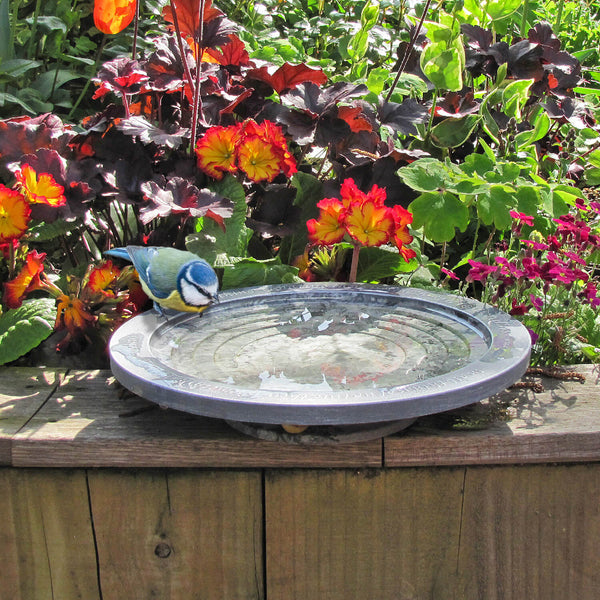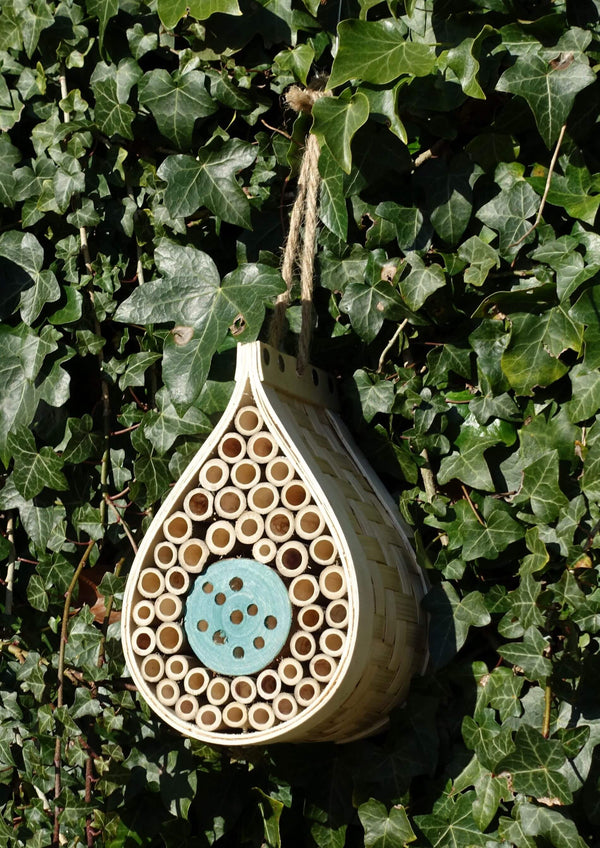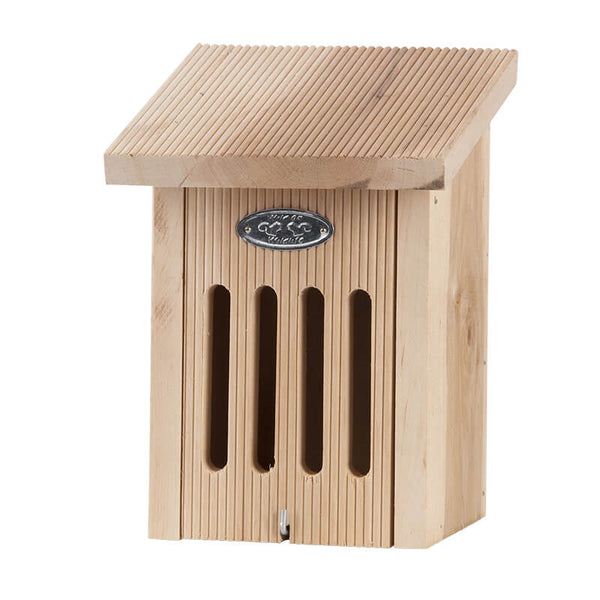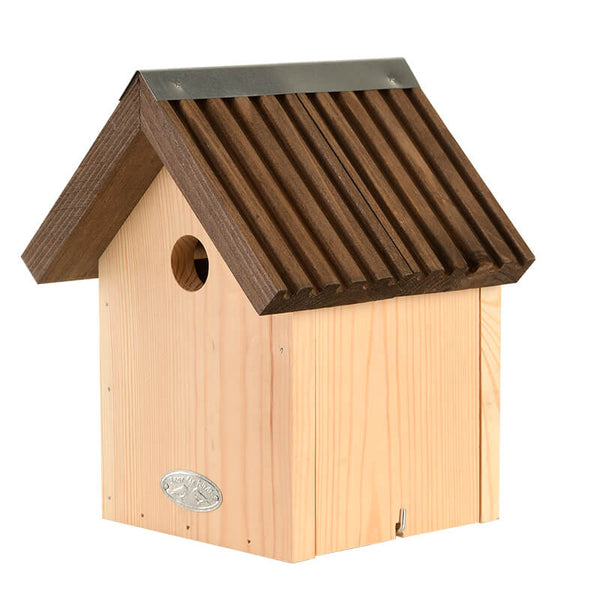How to Attract Wildlife to your Garden - 10 top tips
From birds and bees to foxes and frogs, the UK is brimming with beautiful wildlife and we’re lucky enough to be able to discover an array of species from our own doorsteps. However, if we don’t act now to help our wildlife, this luck could run out. Between 1970 and 2013, 56% of UK species declined[1] and this decline has continued ever since. It is our responsibility to act now so that our future generations can continue enjoying the brilliant British wildlife.
No matter the style, size, or location of your garden, we have some great tips to encourage wildlife to join you in enjoying your outside space, whilst also helping to care and nurture these species and combat the decline in population.
Below we offer 10 tips on how to attract wildlife to your garden and bring some of that local wildlife to your door.
1. Offer a water source
Whether you install a pond, water feature, or just put out a bowl, offering a water feature at a height that can be accessed by an array of wildlife is an effective way to attract wildlife to your garden as well as providing an easy source of drinking water for animals.
It’s important to keep the water topped up all year round and in the cooler months, ensure it is not frozen over as this is the time that wildlife will be struggling to find much-needed fluid.
An open water source could see small mammals, wild birdsm butterflies and other insects venture into your space. A wildlife friendly garden always has a great source of water.
2. Say hello to hedgehogs
Each night, the average British hedgehog will walk 2km looking for food, mates, or suitable nesting spots.

By installing a small gap at the bottom of your fence, you can help hedgehogs on their travels by making it easy to pass through your garden. Creating a hedgehog hole is a win/win for all, you’ll be helping the hedgehogs to reserve their energy whilst also avoiding holes being dug by the animals too. These are also known as a hedgehog highway - what an awesome name.
Leave a plate of hedgehog food nearby too, ideally in a quiet spot of the garden, to help feed any hedgehog visitors.
It’s estimated that the hedgehog population has decreased by 98% since the 1950s[2] so we all need to do our part to help our spiky friends.
You could increase the chances further of seeing regular hedgehog visitors in your garden by adding a hedgehog house. A hedgehog house will provide hedgehogs with a safe space to keep warm in cold weather and safe from other predators.
3. Brilliant garden birds
Birds are always a welcome addition to any wildlife enthusiast’s garden. From the glorious sight of a pair of birds swooping past to the cheery sounds of the morning tweeting, there is no doubt that birds spread joy wherever they go. And British garden birds are very common to see too!

One of the best ways to attract birds to your garden is to set up a bird feeder. Bird feeders can either be hung from your tree or fence or can be freestanding and we recommend having a mixture of both if you have the space. Depending on the time of year and the type of bird you want to attract, you can offer a range of bird-friendly treats from suet balls to mealworms.
To help attract birds it can also help to hang your bird feeders in safer places from predators such as cats. Wild birds will soon come back to your garden if they know they have a safe bird feeder and bird bath to enjoy!
Birds also need somewhere warm and dry to nest which can be hard to come by in the colder months. Install some nesting boxes (or bird boxes) or areas to your garden to create a safe and secure environment for bird species. A bird box is essentially a man made home for birds to nest in. We do offer a range of species specific bird boxes on our website as it isn't a case of one size fits all and they don't have to be just a plain wooden box - out Giant Roost Nest Pocket is a fun nest box suitable for a range of birds!
Birds can struggle to find appropriate nesting sites so these boxes really will encourage wildlife into your garden.
A bird table will also encourage birds to your garden, not only keeping them cool and offering a drink during summer! Did you know a bird bath is actually even more critical during winter months when natural sources may be frozen?
4. Build a bug hotel
Despite its name, a bug hotel doesn’t just attract bugs. By building holes of varying sizes, you can create hiding spots for everything from smaller species such as beetles, spiders, woodlice, and ants to bigger animals such as hedgehogs and frogs.
Bug hotels are easy to make and can be done so using materials you can often find around the garden such as stones, leaves or sticks. If you’re short on time, you can also purchase ready-made bug hotels too.
Once you have your bug hotel set up it shouldn't take too long to attract insects into your garden. These harmless insects will appreciate a shelter to use and you could see many insects using your insect hotel.
Your insect hotel can be made from a hug range of recycled materials and dead wood found laying around your garden and hibernating insects might appreciate some of that up-cycled material!
Why not have some fun and play Bug Hotel Bingo with your little ones? The first one to spot all the species on their card wins!
5. Install a pond to encourage wildlife
Attract some water loving wildlife and other small animals with the installation of a garden pond.
Ideally your pond should have varying depths so that it can be used as a water source, somewhere to bathe and for species such as frogs, somewhere to swim.
Even just a small pond can help attract a range of amazing wildlife to your garden but the bigger, the better.

By adding some plants to your pond, you’ll be able to enjoy the beautiful sight of dragonflies hovering around. Female dragonflies require floating plants to lay their eggs on the underside, so you’ll also be helping to increase the population of this species too.
Wildlife will also prefer natural water over the water from your hose so save water in a water butt or barrel and top the pond up as and when required using this. This is also better for the environment and will help save some pennies for yourself too – leaving more money in the wildlife fund to purchase more delicious food.
6. Create a compost heap
A compost heap is a fantastic way to attract the smaller species of wildlife to your garden and has many benefits.
A heap can provide a safe space and source of food for creatures including beetles, slow-worms, toads and even birds. What’s great about a compost heap is that most species it entices eat insects and slugs that would be eating your beautiful garden plants, so they act as a natural pest control too. This reduces the need for pesticides and harmful chemicals in the garden so as well as helping the food cycle of wildlife, it’s also better for the environment too.
Your very own compost can help with other garden wildlife too!
7. Provide food for butterflies
In the UK we’re fortunate enough to have 59 species of butterfly[3]. However, like many other wildlife species, butterfly population is on the decline so we must all do our bit to protect these butterflies.
A great way to help encourage butterflies to your garden, whilst also helping fight the decline in population, is to offer food sources. From nectar-rich flowers to butterfly feeders, there are lots of inexpensive ways to attract butterflies.
Butterflies love sweet foods and in the cooler months, it can be harder for them to find nectar from spring/summer blooms so by leaving out over-ripe fruit, you can provide the energy boost the butterflies desperately need to get through autumn and winter.
8. Bring in the bees
Bees are an integral part of our ecosystem so attracting bees to our garden to support the fight against the population decline is so important. Bees are needed to pollinate the food that the human population need to survive but they also pollinate the trees and flowers that provide habitats for other wildlife species. The impact of a bee’s work is huge.

Bee friendly plants include lavender, alliums and catmint (all of which are purple as bees are able to see purple much more clearly!). Having said that there are a huge range of flowering plants that bees love too including:
-
Foxgloves
-
Honeysuckle
-
Winter Clematis
-
Bluebells
-
Bugle (great for early spring!)
-
Crab apple
-
Rosemary
-
Teasel
-
Thyme
-
Primrose
-
Ivy
Nectar rich plants and pollen is the name of the game! So choose plants carefully.
There’s nothing quite like the sight, and sound, of a bee buzzing from flower to flower. To attract bees to our garden, you could fill your garden with bee-friendly flowers. The good news is, for those of us who aren’t very green-fingered, bees love flowers that require little to no maintenance and can easily be grown from the scattering of seeds.
You can also create a safe home for bees in your garden by installing bee boxes.
9. Let your grass grow for more garden wildlife
Wildlife love wildflower meadows but not all of us have the space to create a meadow in our back garden. However, even a small patch of lawn that has been left to grow is a fantastic way to entice wildlife into your garden.
The longer grass provides shelter for smaller mammals including mice, shrews and voles as well as providing a safe area for smaller species to breed.
You’ll also be able to spot the glistening webs created by spiders to catch flies which makes a beautiful sight in the early morning dew.
Long grass could create shelter for small creatures too!
10. Grow some trees and shrubs
In addition to the brightly coloured wildflowers that encourage visits from butterflies and bees, you should also grow trees and shrubs where possible.
Trees and shrubs support a wildlife friendly garden by helping to provide shelter and they also provide food from the flowers, fruits and seeds produced.
Just one tree can support hundreds of different species including birds, bats and squirrels so is an amazing investment in the future of our British wildlife.
Climbing plants are also a great choice for wildlife friendly gardening. They offer valuable outdoor spaces and food for garden wildlife. They can also look amazing too!
Extra Tip - Bats!
We've added in a number 11 due to popular demand. We get asked a lot of questions about how to attract bats into your garden. Wildlife gardening enthusiasts love these small mammals and they're becoming a popular site for those with fruit trees and bat boxes in their garden.

Bat boxes are very important to bats as these wild creatures need safe places to be during the day. They can be relatively easy to make but you can also buy them too. They look nice hung around climbing plants.
Another important part to attracting bats is to have the right food source available. These smaller animals love night scented flowers and plants such as primrose
Conclusion
Hopefully these tips have left you feeling inspired to go out and create a wildlife haven in your own outside space. When it comes to supporting our wildlife, every little really does help. Whether you have the space to install a large tree or shrubbed area, or if you have a small balcony with just enough space for a bird feeder, you’ll be making a huge difference.
There really is no better way to start the day than by enjoying a spot of wildlife watching and knowing that you’ve done your bit to help future-proof the British wildlife species. You'll see an abundance of native species by using some of our above top tips.
To keep up to date with the latest wildlife news and tips and tricks, make sure to follow us on Facebook and Instagram (insert links). We also love to see pictures of your outside space and the visitors you’ve attracted with our tips so make sure to tag us in your snaps.
What species are you most excited about welcoming to your garden?
[1] https://www.nhm.ac.uk/discover/british-wildlife.html
[2] https://www.wwf.org.uk/updates/5-tips-how-transform-your-garden-wildlife-haven
[3] https://www.woodlandtrust.org.uk/blog/2020/03/how-to-attract-butterflies/










